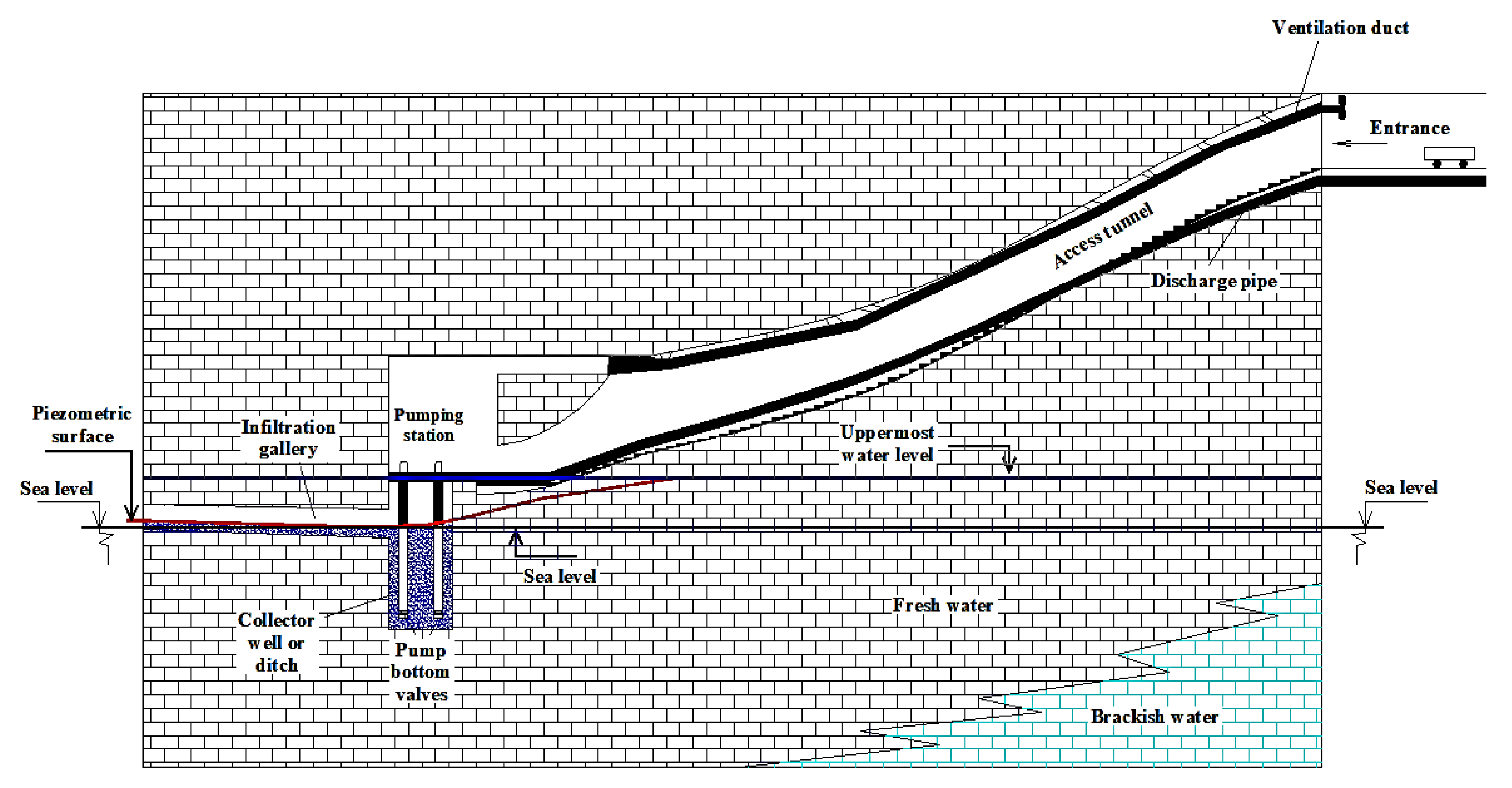Challenges and Opportunities for Sustainable Management of Water Resources in the Island of Crete, Greece
Abstract
1. Prolegomena
2. Historical Evolution of Water Resources Management in Crete
3. The Physical Setting Demographics, Activities and Land Use
3.1. Location Morphology Population and Economic Activities
3.2. Geology and Hydrogeology
3.3. Climate
3.4. Land Use
4. Water Management
4.1. Administrative Structure and Principal Legislation
4.2. Water Availability and Climate Variability Impacts
4.3. Water Uses and Critical Topics
4.4. Conventional Water Resources
4.4.1. Surface
4.4.2. Groundwater
4.5. Potential for the Use of Non-Conventional Water Sources
4.5.1. Stormwater and Wastewater Management
4.5.2. Water Reuse
- Improve water availability and strengthen the adaptation potential to climate variability;
- Support crop production and reduce production cost by water and nutrients supply;
- Enhance the transition toward circular economy agricultural practices;
- Reduce pollution risks for water resources;
- Protect groundwater, the major current source of irrigation water, from overexploitation and degradation.
4.5.3. Brackish Waters
- (a)
- The major hydrological characteristic of the Almyros spring is that the water becomes brackish under low flow rates (less than 12 m3/s), i.e., about nine to ten months per year. The total dissolved solids (TDS) decrease from a maximum concentration of 5 g/L in October to less than 0.30 g/L during the following maximum discharge flow rate. Water from Almyros spring could serve Iraklion city with potable water for 35–45 day/year when the concentration of TDS remains below 0.30 g/L. The possibility of constructing a reservoir outside of Almyros basin (e.g., Taveronas basin) for storing the produced fresh water, when the TDS concentration is less than 0.30 g/L, and using it for water supply of Iraklion municipality has been evaluated [107]. An exploitable volume of 31.10 hm3/year of fresh water, to be stored during the 30 day/year (conservative forecast) when the maximum discharge flow rate is greater than 12 m3/s).
- (b)
- Several investigations have been carried out since 1964 to understand the spring function mechanism and reduce the seawater intrusion in the Almyros karstic system [108,109]. A small dam was constructed in mid 1970s (Figure 8) based on a previous study [110]. The objective of the dam to raise the water up to 10 m above the sea level to increase the hydraulic pressure in the karstic system and to reduce the seawater intrusion. The experiment was carried out at the end 1977, just for a few days, due to a sudden flood event. Based on the data obtained, no improvement was found in the spring water quality. However, in another experiment, carried out from 12 February to 15 September 1987, significant TDS concentration reductions were assessed [106]. In an earlier study, the operation of brackish karst springs was simulated with the MODKARST model. The simulations revealed that sea water intrusion depends on the difference between the freshwater and seawater density. Moreover, with regard to chloride concentration during the depletion period, the difference is due to the lower pressure in the freshwater channel compared to the channel carrying the seawater [111]. Another study reported that the sea intrusion could be prevented by raising the spring water outlet, through the construction of a new dam of an estimated elevation of 26 m above the sea level [112].
- (c)
- Recently, it was reported that increasing the height of the dam up to 25 m would minimize sea water intrusion [113]. It should be noted that none of the coastal brackish springs in Crete are 25 m above sea level [114]. Ntaskas (2018) correlates the flow rate of the Almyros spring with rainfall in the Idi (Psiloritis) mountain and the TDS concentration. Specifically, at a flow rate of less than 5 m3/s, the TDS concentration is greater than 5 g/L and at a flow rate above 12 m3/s, it is less than 0.4 g/L. Moreover, the hydraulic pressure in the karstic system under the high flow rates should increase significantly. Furthermore, Ntaskas (2018) found that a dam at an elevation of 25 m, estimated to cost 4 million €, would support a small hydroelectric power plant of 2.4 MW with an annual energy output of 11 million kWh.
- (d)
- Finally, in another earlier study, the construction of an underground infiltration gallery inland, upstream of the salinization zone, to optimize the exploitation the karstic spring’s aquifer (Figure 9) was recommended [115]. Such a project is believed to be a long-term and definitive solution to the water supply problem of the Iraklion municipality and the adjacent villages.
4.5.4. Desalination
5. Reorganization of Water Management at Local Level and Water Safety Plans
5.1. Municipal Water Supply and Sewerage Enterprises (DEYA)
5.2. Water Safety Plans
- Drinking Water Services should prepare Water Safety Plans in each DEYA to ensure the quality of drinking water in accordance with the guidelines of Directive 98/83/EU [121] and those of the World Health Organization (WHO) [122] for the quality of drinking water. These plans are considered to be the most effective means for continuously ensuring the safety and acceptance of drinking water supply. They require a risk assessment, which includes all the necessary steps in water supply from the catchment to the consumer, followed by the implementation and monitoring of risk management control measures, with emphasis on high-risk hazards.
- Moreover, plans must be developed for water management, mainly for operation of water supply infrastructures under emergency conditions. Such an Emergency Plan has been recently prepared by the Development Organization of Crete (OAK. SA), which can be considered as pioneering, if not at European, certainly at a national level [123]. Well done to those who designed and implemented it, even if it may be unnecessary; κάλλιον το προλαμβάνειν ή το θεραπεύειν, i.e., “it is better to prevent than to cure,” Hippocrates (460–370 BC).
6. Water and Energy
7. Water Sustainability Issues and Opportunities
7.1. Uneven Availability of Water Resources
7.2. Efficient Water Use in Agriculture
7.3. Low Agricultural Water Use Efficiencies
7.4. Non-Revenue Water Losses
7.5. Limited Water Reuse
7.6. Limited Use of Alternative Water Sources
7.7. Water and Energy Production Nexus
7.8. Local Water Management
7.9. Knowledge Gaps
8. Epilogue
- Uneven availability of water resources;
- Over-exploitation of groundwater;
- Low agricultural water use efficiencies;
- High non-revenue water losses;
- Limited water reuse;
- Limited use of alternative water sources;
- Water energy production nexus;
- Local management concerns.
Author Contributions
Funding
Acknowledgments
Conflicts of Interest
Appendix A
| Critical Topics | Impacts-Risks | Major Goals | Proposed Measures |
|
|
| |
|
|
References
- Chen, B.; Han, M.Y.; Peng, K.; Zhou, S.L.; Shao, L.; Wu, X.F.; Wei, W.D.; Liu, S.Y.; Li, Z.; Li, J.S.; et al. Global land-water nexus: Agricultural land and freshwater use embodied in worldwide supply chains. Sci. Total Environ. 2018, 613–614, 931–943. [Google Scholar] [CrossRef] [PubMed]
- Godfray, H.C.J.; Beddington, J.R.; Crute, I.R.; Haddad, L.; Lawrence, D.; Muir, J.F.; Pretty, J.; Robinson, S.; Thomas, S.M.; Toulmin, C. Food Security: The Challenge of Feeding 9 Billion People. Science 2010, 327, 812–818. [Google Scholar] [CrossRef] [PubMed]
- Schneider, U.A.; Havlík, P.; Schmid, E.; Valin, H.; Mosnier, A.; Obersteiner, M.; Böttcher, H.; Skalský, R.; Balkovič, J.; Sauer, T.; et al. Impacts of population growth, economic development, and technical change on global food production and consumption. Agric. Syst. 2011, 104, 204–215. [Google Scholar] [CrossRef]
- Gosling, S.N.; Arnell, N.W. A global assessment of the impact of climate change on water scarcity. Clim. Chang. 2016, 134, 371–385. [Google Scholar] [CrossRef]
- Diffenbaugh, N.S.; Giorgi, F. Climate change hotspots in the CMIP5 global climate model ensemble. Clim. Chang. 2012, 114, 813–822. [Google Scholar] [CrossRef]
- Jacob, D.; Kotova, L.; Teichmann, C.; Sobolowski, S.P.; Vautard, R.; Donnelly, C.; Koutroulis, A.G.; Grillakis, M.G.; Tsanis, I.K.; Damm, A.; et al. Climate Impacts in Europe Under +1.5 °C Global Warming. Earth’s Future 2018, 6, 264–285. [Google Scholar] [CrossRef]
- Guiot, J.; Cramer, W. Climate change: The 2015 Paris Agreement thresholds and Mediterranean basin ecosystems. Science 2016, 354, 465–468. [Google Scholar] [CrossRef]
- Sivapalan, M.; Konar, M.; Srinivasan, V.; Chhatre, A.; Wutich, A.; Scott, C.A.; Wescoat, J.L.; Rodríguez-Iturbe, I. Socio-hydrology: Use-inspired water sustainability science for the Anthropocene. Earth’s Future 2014, 2, 225–230. [Google Scholar] [CrossRef]
- Orlove, B.; Caton, S.C. Water Sustainability: Anthropological Approaches and Prospects. Annu. Rev. Anthropol. 2010, 39, 401–415. [Google Scholar] [CrossRef]
- Cosgrove, W.J.; Loucks, D.P. Water management: Current and future challenges and research directions. Water Resour. Res. 2015, 51, 4823–4839. [Google Scholar] [CrossRef]
- Varouchakis, E.A.; Corzo, G.A.; Karatzas, G.P.; Kotsopoulou, A. Spatio-temporal analysis of annual rainfall in Crete, Greece. Acta Geophys. 2018, 66, 319–328. [Google Scholar] [CrossRef]
- Tsagarakis, K.P.; Dialynas, G.E.; Angelakis, A.N. Water resources management in Crete (Greece) including water recycling and reuse and proposed quality criteria. Agric. Water Manag. 2004, 66, 35–47. [Google Scholar] [CrossRef]
- Chartzoulakis, K.S.; Paranychianakis, N.V.; Angelakis, A.N. Water resources management in the Island of Crete, Greece, with emphasis on the agricultural use. Water Policy 2001, 3, 193–205. [Google Scholar] [CrossRef]
- CMD. Common Ministerial Decision. Management Plan as a River Basin of the Water Region of Crete; No 163. ΦΕΚ 570/B’/2015; Ministry of Environment, Energy and Climate Change: Athens, Greece, 2015. (In Greek) [Google Scholar]
- CMD. Common Ministerial Decision. Management Plan as a River Basin of the Water Region of Crete; No 896, ΦΕΚ Β/4666/2017; Ministry of Environment, Energy and Climate Change: Athens, Greece, 2017. (In Greek) [Google Scholar]
- Tsagarakis, K.P.; Paranychianakis, N.V.; Angelakis, A.N. Water Supply and Wastewater Services in Greece. European Water Management between Regulation and Competition, Aqualibrium Project, EU Directorate General for Research, Global Change and Ecosystems; Mohajeri, S., Ed.; B-1049; European Union: Brussels, Belgium, 2003; pp. 151–170. [Google Scholar]
- Gori, R.; Lubello, C.; Ferrini, F.; Nicese, F. Reclaimed municipal wastewater as source of water and nutrients for plant nurseries. Water Sci. Technol. 2004, 50, 69–75. [Google Scholar] [CrossRef][Green Version]
- Papadopoulos, I.; Savvides, S. Optimisation of the use of nitrogen in the treated wastewater reused for irrigation. Water Sci. Technol. Water Supply 2003, 3, 217–221. [Google Scholar] [CrossRef]
- Lal, K.; Minhas, P.S.; Yadav, R.K. Long-term impact of wastewater irrigation and nutrient rates II. Nutrient balance, nitrate leaching and soil properties under peri-urban cropping systems. Agric. Water Manag. 2015, 156, 110–117. [Google Scholar] [CrossRef]
- Lu, S.; Zhang, X.; Liang, P. Influence of drip irrigation by reclaimed water on the dynamic change of the nitrogen element in soil and tomato yield and quality. J. Clean. Prod. 2016, 139, 561–566. [Google Scholar] [CrossRef]
- Angelakis, A.N.; Koutsoyiannis, D.; Tchobanoglous, G. Urban wastewater and stormwater technologies in ancient Greece. Water Res. 2005, 39, 210–220. [Google Scholar] [CrossRef]
- Angelakis, A.; Dialynas, M.; Despotakis, V. Evolution of Water Supply Technologies in Crete, Greece through the Centuries; IWA Publishing: London, UK, 2012; pp. 227–258. [Google Scholar]
- Koutsoyiannis, D.; Zarkadoulas, N.; Angelakis, A.N.; Tchobanoglous, G. Urban water management in Ancient Greece: Legacies and lessons. J. Water Resour. Plan. Manag. 2008, 134, 45–54. [Google Scholar] [CrossRef]
- Davaras, K. Guide to Cretan Antiquities; Noyes Press: Park Ridge, NJ, USA, 1976. [Google Scholar]
- Strataridakis, A.; Chalkiadakis, E.; Gigourtakis, N. Water Supply of Iraklion City (Greece) through the ages. Evolution of Water Supply Technologies through the Mellenia; IWA Publications: London, UK, 2012; pp. 467–496. [Google Scholar]
- Angelakis, A.N.; Mays, L.W.; Koutsoyiannis, D.; Mamassis, N. Evolution of Water Supply through the Millennia; IWA Publishing: London, UK, 2012. [Google Scholar]
- Enriquez, J.; Tipping, D.; Lee, J.-J.; Vijay, A.; Kenny, L.; Chen, S.; Mainas, N.; Holst-Warhaft, G.; Steenhuis, T. Sustainable Water Management in the Tourism Economy: Linking the Mediterranean’s Traditional Rainwater Cisterns to Modern Needs. Water 2017, 9, 868. [Google Scholar] [CrossRef]
- Antoniou, G.; Xarchakou, R.; Angelakis, A. Water cistern systems in Greece from Minoan to Hellenistic period. In Proceedings of the 1st IWA International Symposium on Water and Wastewater Technologies in Ancient Civilizations, National Fountation for Agricultural Research, Institute of Iraklion, Iraklion, Greece, 28–30 October 2006; pp. 28–30. [Google Scholar]
- Angelakis, A. Hydro-technologies in the Minoan Era. Water Sci. Technol. Water Supply 2017, 17, 1106–1120. [Google Scholar] [CrossRef]
- Mosso, A. Escursioni nel Mediterraneo e gli scavi di Creta; Treves: Milano, Italy, 1910; Volume 1. [Google Scholar]
- Gray, H.F. Sewerage in ancient and mediaeval times. Sew. Work. J. 1940, 12, 939–946. [Google Scholar]
- Markonis, Y.; Angelakis, A.; Christy, J.; Koutsoyiannis, D. Climatic variability and the evolution of water technologies in Crete, Hellas. Water Hist. 2016, 8, 137–157. [Google Scholar] [CrossRef]
- HSA. Hellenic Statistical Authority. 2019. Available online: http://www.statistics.gr/el/statistics/-/publication/SAM03/ (accessed on 15 May 2020).
- HSA. Hellenic Statistical Authority. Real Population of Greece. Athens, Greece. 2002. Available online: http://www.statistics.gr (accessed on 15 May 2020).
- HSA. Hellenic Statistical Authority. Statistic of Tourism for the Years 1994–1996; HAS: Athens, Greece, 1999. [Google Scholar]
- HSA. Hellenic Statistical Authority. 2011. Available online: https://www.statistics.gr/en/provision-of-statistical-data (accessed on 15 May 2020).
- MEE. Ministry of Environment and Energy. 2015. Available online: http://www.ypeka.gr/Default.aspx?tabid=245&language=en-US (accessed on 10 May 2020).
- Gaki-Papanastassiou, K.; Karymbalis, E.; Papanastassiou, D.; Maroukian, H. Quaternary marine terraces as indicators of neotectonic activity of the Ierapetra normal fault SE Crete (Greece). Geomorphology 2009, 104, 38–46. [Google Scholar] [CrossRef]
- Tzoraki, O.; Kritsotakis, M.; Baltas, E. Spatial Water Use Efficiency Index towards resource sustainability: Application in the island of Crete, Greece. Int. J. Water Resour. Dev. 2015, 31, 669–681. [Google Scholar] [CrossRef]
- Fassoulas, C. The tectonic development of a Neogene basin at the leading edge of the active European margin: The Heraklion basin, Crete, Greece. J. Geodyn. 2001, 31, 49–70. [Google Scholar] [CrossRef]
- Papanikolaou, D. The Geology of Greece; Publication of the University of Athens: Athens, Greece, 1986; 240p. [Google Scholar]
- Malagò, A.; Efstathiou, D.; Bouraoui, F.; Nikolaidis, N.P.; Franchini, M.; Bidoglio, G.; Kritsotakis, M. Regional scale hydrologic modeling of a karst-dominant geomorphology: The case study of the Island of Crete. J. Hydrol. 2016, 540, 64–81. [Google Scholar] [CrossRef]
- MEDIWAT. State of the Art of Water Resources in Mediterranean Islands. 2013. Available online: http://www.mediwat.eu/sites/default/files/D.3.1.1.pdf (accessed on 15 May 2019).
- Angelakis, A.N.; Spyridakis, S.V. The status of water resources in Minoan times: A preliminary study. In Diachronic Climatic Impacts on Water Resources; Springer: Berlin/Heidelberg, Germany, 1996; pp. 161–191. [Google Scholar]
- Angelakis, A. Evolution of rainwater harvesting and use in Crete, Hellas, through the millennia. Water Sci. Technol. Water Supply 2016, 16, 1624–1638. [Google Scholar] [CrossRef]
- Voudouris, K.; Mavrommatis, T.; Daskalaki, P.; Soulios, G. Rainfall Variations in Crete Island (Greece) and Their Impacts on Water Resources; Serie: Hidrogeologia y aguas subterráneas; Publicaciones del Instituto Geologico y Minero de Espana: Madrid, Spain, 2006; pp. 453–463. [Google Scholar]
- NOAA. National Oceanic and Atmospheric Administration—National Centers for Environmental Information. 2019. Available online: http://www.ncdc.noaa.gov/cdo-web/datasets (accessed on 15 May 2020).
- Platakis, E. The Climate of Crete; Cretan Estia: Iraklion, Greece, 1964. (In Greek) [Google Scholar]
- Koutroulis, A.G.; Tsanis, I.K.; Daliakopoulos, I.N. Seasonality of floods and their hydrometeorologic characteristics in the island of Crete. J. Hydrol. 2010, 394, 90–100. [Google Scholar] [CrossRef]
- Sarris, A.; Maniadakis, M.; Lazaridou, O.; Kalogrias, V.; Bariotakis, M.; Pirintsos, S.A. Studying land use patterns in Crete Island, Greece, through a time sequence of landsat images and mapping vegetation patterns. Wseas Trans. Environ. Dev. 2005, 1, 272–279. [Google Scholar]
- Leddra. Crete Socio-Ecological System (SES). 2010. Available online: http://leddris.aegean.gr/index.html (accessed on 15 May 2020).
- WFD. European Water Framework Directive. Directive 2000/60/EC of the European Parliament and of the Council Establishing a Framework for the Community Action in the Field of Water Policy; WFD: Brussels, Belgium, 2000. [Google Scholar]
- EC-COM. European Commission. From the Commission to the European Parliament, the Council, the European Economic and Social Committee and the Committee of the Regions on the Implementation of the Circular Economy Action Plan (190 Final); European Commission: Brussels, Belgium, 2019. [Google Scholar]
- EEA. Report No 6. Tracking Progress towards Europe’s Climate and Energy Targets until 2020; Trends and projections in Europe; EEA: Copenhagen, Denmark, 2014. [Google Scholar]
- Koutsoyiannis, D.; Andreadakis, A.; Mavrodimou, R.; Christofides, A.; Mamassis, N.; Efstratiadis, A.; Koukouvinos, A.; Karavokiros, G.; Kozanis, S.; Mamais, D.; et al. National Programme for the Management and Protection of Water Resources, Support on the Compilation of the National Programme for Water Resources Management and Preservation; Department of Water Resources and Environmental Engineering—National Technical University of Athens: Athens, Greece, 2008; p. 748. [Google Scholar] [CrossRef]
- Koutroulis, A.G.; Tsanis, I.K.; Daliakopoulos, I.N.; Jacob, D. Impact of climate change on water resources status: A case study for Crete Island, Greece. J. Hydrol. 2013, 479, 146–158. [Google Scholar] [CrossRef]
- Tsanis, I.K.; Koutroulis, A.G.; Daliakopoulos, I.N.; Jacob, D. Severe climate-induced water shortage and extremes in Crete. Clim. Chang. 2011, 106, 667–677. [Google Scholar] [CrossRef]
- Vautard, R.; Gobiet, A.; Sobolowski, S.; Kjellström, E.; Stegehuis, A.; Watkiss, P.; Mendlik, T.; Landgren, O.; Nikulin, G.; Teichmann, C. The European climate under a 2 C global warming. Environ. Res. Lett. 2014, 9, 034006. [Google Scholar] [CrossRef]
- Koutroulis, A.G.; Grillakis, M.G.; Daliakopoulos, I.N.; Tsanis, I.K.; Jacob, D. Cross sectoral impacts on water availability at +2 °C and +3 °C for east Mediterranean island states: The case of Crete. J. Hydrol. 2016, 532, 16–28. [Google Scholar] [CrossRef]
- Brilli, L.; Lugato, E.; Moriondo, M.; Gioli, B.; Toscano, P.; Zaldei, A.; Leolini, L.; Cantini, C.; Caruso, G.; Gucci, R.; et al. Carbon sequestration capacity and productivity responses of Mediterranean olive groves under future climates and management options. Mitig. Adapt. Strat. Glob. Chang. 2019, 24, 467–491. [Google Scholar] [CrossRef]
- Chartzoulakis, K.; Psarras, G. Global change effects on crop photosynthesis and production in Mediterranean: The case of Crete, Greece. Agric. Ecosyst. Environ. 2005, 106, 147–157. [Google Scholar] [CrossRef]
- Koutroulis, A.G.; Vrohidou, A.-E.K.; Tsanis, I.K. Spatiotemporal Characteristics of Meteorological Drought for the Island of Crete. J. Hydrometeorol. 2011, 12, 206–226. [Google Scholar] [CrossRef]
- Koutsoyiannis, D. Hydrology and change. Hydrol. Sci. J. 2013, 58, 1177–1197. [Google Scholar] [CrossRef]
- Koutsoyiannis, D.; Makropoulos, C.; Langousis, A.; Baki, S.; Efstratiadis, A.; Christofides, A.; Karavokiros, G.; Mamassis, N. HESS Opinions: “Climate, hydrology, energy, water: Recognizing uncertainty and seeking sustainability”. Hydrol. Earth Syst. Sci. 2009, 13, 247–257. [Google Scholar] [CrossRef]
- Change of the Irrigated Area from 1995 until the Present; Hellenic Statistical Authority: Pireas, Greece, 2016; Available online: https://www.statistics.gr/en/provision-of-statistical-data (accessed on 15 May 2020).
- EUROSTAT. European Statistics Database [WWWDocument]. Eurostat URL. Available online: http://ec.europa.eu/eurostat/statistics-explained/index.php/Agri-environmental_indicator_-_irrigation (accessed on 11 January 2017).
- Karatzas, G.P.; Dokou, Z. Optimal management of saltwater intrusion in the coastal aquifer of Malia, Crete (Greece), using particle swarm optimization. Hydrogeol. J. 2015, 23, 1181–1194. [Google Scholar] [CrossRef]
- Papadopoulou, M.; Karatzas, G.; Koukadaki, M.; Trichakis, Y. Modeling the saltwater intrusion phenomenon in coastal aquifers–A case study in the industrial zone of Herakleio in Crete. Glob. Nest J. 2005, 7, 197–203. [Google Scholar]
- Tsanis, I.K.; Coulibaly, P.; Daliakopoulos, I.N. Improving groundwater level forecasting with a feedforward neural network and linearly regressed projected precipitation. J. Hydroinform. 2008, 10, 317–330. [Google Scholar] [CrossRef]
- Varouchakis, E.A.; Theodoridou, P.G.; Karatzas, G.P. Spatiotemporal geostatistical modeling of groundwater levels under a Bayesian framework using means of physical background. J. Hydrol. 2019, 575, 487–498. [Google Scholar] [CrossRef]
- Varouchakis, E.A. Modeling of temporal groundwater level variations based on a Kalman filter adaptation algorithm with exogenous inputs. J. Hydroinform. 2017, 19, 191–206. [Google Scholar] [CrossRef]
- Pappa, A.; Dokou, Z.; Karatzas, G.P. Saltwater intrusion management using the swi2 model: Application in the coastal aquifer of hersonissos, crete, greece. Desalin. Water Treat. 2017, 99, 49–58. [Google Scholar] [CrossRef]
- Morianou, G.G.; Kourgialas, N.N.; Psarras, G.; Koubouris, G.C. Mapping sensitivity to desertification in Crete (Greece), the risk for agricultural areas. J. Water Clim. Chang. 2018, 9, 691–702. [Google Scholar] [CrossRef]
- Croke, B.; Cleridou, N.; Kolovos, A.; Vardavas, I.; Papamastorakis, J. Water resources in the desertification-threatened Messara Valley of Crete: Estimation of the annual water budget using a rainfall-runoff model. Environ. Model. Softw. 2000, 15, 387–402. [Google Scholar] [CrossRef]
- Varouchakis, E.; Palogos, I.; Karatzas, G. Application of Bayesian and cost benefit risk analysis in water resources management. J. Hydrol. 2016, 534, 390–396. [Google Scholar] [CrossRef]
- Varouchakis, E.A.; Yetilmezsoy, K.; Karatzas, G.P. A decision-making framework for sustainable management of groundwater resources under uncertainty: Combination of Bayesian risk approach and statistical tools. Water Policy 2019, 21, 602–622. [Google Scholar] [CrossRef]
- Georgopoulou, E.; Mirasgedis, S.; Sarafidis, Y.; Vitaliotou, M.; Lalas, D.P.; Theloudis, I.; Giannoulaki, K.D.; Dimopoulos, D.; Zavras, V. Climate change impacts and adaptation options for the Greek agriculture in 2021–2050: A monetary assessment. Clim. Risk Manag. 2017, 16, 164–182. [Google Scholar] [CrossRef]
- Udias, A.; Pastori, M.; Malago, A.; Vigiak, O.; Nikolaidis, N.P.; Bouraoui, F. Identifying efficient agricultural irrigation strategies in Crete. Sci. Total Environ. 2018, 633, 271–284. [Google Scholar] [CrossRef] [PubMed]
- Giannakis, E.; Bruggeman, A.; Djuma, H.; Kozyra, J.; Hammer, J. Water pricing and irrigation across Europe: Opportunities and constraints for adopting irrigation scheduling decision support systems. Water Supply 2015, 16, 245–252. [Google Scholar] [CrossRef]
- Varouchakis, E.; Apostolakis, A.; Siaka, M.; Vasilopoulos, K.; Tasiopoulos, A. Alternatives for domestic water tariff policy in the municipality of Chania, Greece, toward water saving using game theory. Water Policy 2018, 20, 175–188. [Google Scholar] [CrossRef]
- Chifos, C.; Doxastakis, Z.; Romanos, M.C. Public discourse and government action in a controversial water management project: The damming of the Aposelemis River in Crete, Greece. Water Policy 2019, 21, 526–545. [Google Scholar] [CrossRef]
- Voudouris, K.S.; Tsatsanifos, C.; Yannopoulos, S.; Marinos, V.; Angelakis, A.N. Evolution of underground aqueducts in the Hellenic world. Water Supply 2016, 16, 1159–1177. [Google Scholar] [CrossRef]
- Nikolaou, T.; Christodoulakos, I.; Piperidis, P.; Angelakis, A. Evolution of Cretan, Greece Aqueducts. In Proceedings of the 4th IWA International Symposium on Water and Wastewater Technologies in Ancient Civilizations, Coimbra, Portugal, 22–24 March 2014; pp. 17–19. [Google Scholar]
- Lekkas, Ν. The 750 Mineral Springs of Greece; IGME: Athens, Greece, 1938. (In Greek) [Google Scholar]
- Angelakis, A.N.; Antoniou, G.P.; Yapijakis, C.; Tchobanoglous, G. History of Hygiene Focusing on the Crucial Role of Water in the Hellenic Asclepieia (ie, Ancient Hospitals). Water 2020, 12, 754. [Google Scholar] [CrossRef]
- Manutsoglou, E. The Thermal Springs of Asklepieion in Crete, Greece. In Proceedings of the 11th Hydrogeological Conference of Greece, Athens, Greece, 4–6 October 2017; Hellenic Hydrogeology Committee of International Association of Hydrogeologists. IAH: Athens, Greece, 2017. [Google Scholar]
- Steiakakis, E.; Vavadakis, D.; Kritsotakis, M.; Voudouris, K.; Anagnostopoulou, C. Drought impacts on the fresh water potential of a karst aquifer in Crete, Greece. Environ. Earth Sci. 2016, 75, 507. [Google Scholar] [CrossRef]
- Kourgialas, N.N.; Karatzas, G.P.; Dokou, Z.; Kokorogiannis, A. Groundwater footprint methodology as policy tool for balancing water needs (agriculture & tourism) in water scarce islands—The case of Crete, Greece. Sci. Total Environ. 2018, 615, 381–389. [Google Scholar]
- Gikas, P.; Tchobanoglous, G. Sustainable use of water in the Aegean Islands. J. Environ. Manag. 2009, 90, 2601–2611. [Google Scholar] [CrossRef]
- Karydis, M.; Lesvos, I. Eutrophication assessment of coastal waters based on indicators: A literature review. In Proceedings of the International Conference on Environmental Science and Technology, Crete, Greece, 3–5 September 2009. [Google Scholar]
- Angelakis, A. Urban waste-and stormwater management in Greece: Past, present and future. Water Sci. Technol. Water Supply 2017, 17, 1386–1399. [Google Scholar] [CrossRef][Green Version]
- EU. Concerning the Management of Bathing Water Quality and Repealing Directive 76/160/EEC; Official Journal L. 64/37; EU: Brussels, Belgium, 2006. [Google Scholar]
- EU. Directive 2000/60/EC of the European Parliament and of the Council of 23 October 2000 Establishing a Framework for Community Action in the Field of Water Policy; Official Journal L 327, 22/12/2000 P. 0001–0073; EU: Brussels, Belgium, 2000. [Google Scholar]
- EEA. European Environment Agency. Sustainable Water Management. 2018. Available online: https://ec.europa.eu/info/news/sustainability-at-the-water-source_en (accessed on 15 May 2020).
- EU. Urban Wastewater Council Directive of 21 May 1991 concerning urban waste water treatment (91/271/EEC). J. Eur. Commun. 1991, 34, 40. [Google Scholar]
- Paranychianakis, N.V.; Angelakis, A.N.; Leverenz, H.; Tchobanoglous, G. Treatment of Wastewater with Slow Rate Systems: A Review of Treatment Processes and Plant Functions. Crit. Rev. Environ. Sci. Technol. 2006, 36, 187–259. [Google Scholar] [CrossRef]
- De Feo, G.; Galasso, M.; Belgiorno, V. Groundwater recharge in an endoreic basin with reclaimed municipal wastewater. Water Sci. Technol. 2007, 55, 449–457. [Google Scholar] [CrossRef] [PubMed]
- Masciopinto, C.; Carrieri, C. Assessment of water quality after 10 years of reclaimed water injection: The Nardò fractured aquifer (Southern Italy). Groundw. Monit. Remediat. 2002, 22, 88–97. [Google Scholar] [CrossRef]
- Paranychianakis, N.V.; Salgot, M.; Snyder, S.A.; Angelakis, A.N. Water Reuse in EU States: Necessity for Uniform Criteria to Mitigate Human and Environmental Risks. Crit. Rev. Environ. Sci. Technol. 2015, 45, 1409–1468. [Google Scholar] [CrossRef]
- Menegaki, A.N.; Hanley, N.; Tsagarakis, K.P. The social acceptability and valuation of recycled water in Crete: A study of consumers’ and farmers’ attitudes. Ecol. Econ. 2007, 62, 7–18. [Google Scholar] [CrossRef]
- CMD. Common Ministerial Decision. Measures, Limits and Procedures for Reuse of Treated Wastewater; No. 145116; Ministry of Environment, Energy and Climate Change: Athens, Greece, 2011. (In Greek) [Google Scholar]
- EC-COM. European Commission. Proposal for a Regulation of the European Parliament and of the Council on Minimum Requirements for Water Reuse (337 Final); European Commission: Brussels, Belgium, 2018. [Google Scholar]
- Shoushtarian, F.; Negahban-Azar, M. Worldwide Regulations and Guidelines for Agricultural Water Reuse: A Critical Review. Water 2020, 12, 971. [Google Scholar] [CrossRef]
- RC. National Business Plan: Urban Wastewater Management; Region of Crete: Iraklion, Greece, 2019. (In Greek) [Google Scholar]
- Alexopoulos, A. Brackish Water Resources in Crete: Quantities and Characteristics. Desalination Technologies for the Production of Desalinated Water; Karamouzis, D., Alexopoulos, A., Angelakis, A.N., Eds.; Hellenic Union of Municipal Enterprises for Water Supply and Sewerage: Larisa, Greece, 2008; pp. 37–41. (In Greek) [Google Scholar]
- Stevanović, Z. Karst Aquifers-Characterization and Engineering; Springer: Berlin/Heidelberg, Germany, 2015. [Google Scholar]
- Vergis, G. Investigation of the Possibilities Construction a Dam for Storage the Water of Iraklion Almyros Spring. Master’s Thesis, Interdepart. of Water Sciences and Technology, National Technical Univ. of Athens, Athens, Greece, 2006; p. 148. [Google Scholar]
- Arfib, B.; De Marsily, G.; Ganoulis, J. Locating the zone of saline intrusion in a coastal karst aquifer using springflow data. Groundwater 2007, 45, 28–35. [Google Scholar] [CrossRef]
- Tsakiris, G.; Spiliotis, M.; Paritsis, S.; Alexakis, D. Assessing the water potential of karstic saline springs by applying a fuzzy approach: The case of Almyros (Heraklion, Crete). Desalination 2009, 237, 54–64. [Google Scholar] [CrossRef]
- FAO-UNDP. Study of Water Resources and Their Exploitation for Irrigation in Eastern Crete: Study of Almyros Springo Iraklion; Technical Report 3; FAO, UN Development Programme: Iraklion, Greece, 1972. [Google Scholar]
- Maramathas, A. Simulation of Brakish-Karstic Spring. Ph.D. Thesis, School of Chemical Engineering, National Technical University of Athens, Athens, Greece, 2002. [Google Scholar]
- Maramathas, A.; Maroulis, Z.; Marinos-Kouris, D. Blocking sea intrusion in brackish karstic springs. Case Almiros Spring Heraklion Crete Greece Eur. Water 2003, 1, 14–20. [Google Scholar]
- Ntaskas, A. Πρόταση για την αξιοποίηση της πηγής Aλμυρού (Ύδρευση, Άρδευση, Ενέργεια). Patris Newspaper, 30 April 2018 (In Greek). Publisher A. Mykoniatis A.E. Available online: https://www.patris.gr/2018/04/30/protasi-gia-tin-axiopoiisi-tis-pigis-almyroy-ydreysi-ardeysi-energeia (accessed on 20 May 2020).
- Papamastorakis, D.; (Region of Crete, Direction of Water Resources, Iraklion, Greece). Personal communication, 2020.
- Monopolis, D.; Klidopoulou, M. Exploitation of the Brackish-Water Spring of Almyros; DEYA Iraklion: Iraklion, Greece, 2002. [Google Scholar]
- Garcia-Rodriguez, L. Seawater desalination driven by renewable energies: A review. Desalination 2002, 143, 103–113. [Google Scholar] [CrossRef]
- Shannon, M.A.; Bohn, P.W.; Elimelech, M.; Georgiadis, J.G.; Marinas, B.J.; Mayes, A.M. Science and technology for water purification in the coming decades. In Nanoscience and Technology: A Collection of Reviews from Nature Journals; World Scientific: Singapore, 2010; pp. 337–346. [Google Scholar]
- Khawaji, A.D.; Kutubkhanah, I.K.; Wie, J.-M. Advances in seawater desalination technologies. Desalination 2008, 221, 47–69. [Google Scholar] [CrossRef]
- Fritzmann, C.; Löwenberg, J.; Wintgens, T.; Melin, T. State-of-the-art of reverse osmosis desalination. Desalination 2007, 216, 1–76. [Google Scholar] [CrossRef]
- UNEP/MAP. Sea water desalination in the Mediteranean: Assessment and guidelines; MAP Technical Reports Series; UNEP/MAP: Nairobi, Kenya, 2003. [Google Scholar]
- EU. Council Directive 98/83/EC of 3 November 1998 on the Quality of Water Intended for Human Consumption; Official Journal L 330, 05/12/1998 P. 0032–0054; EU: Brussels, Belgium, 1998. [Google Scholar]
- WHO. Water Safety Plan Manual: How to Develop and Implement a Water Safety Plan; WHO and IWA: Genova, Switzerland, 2009. [Google Scholar]
- Development Organization of Crete (OAK, SA). The no 3278/16/03/2020 Decision Approving and Implementing of an Emergency Plan for Continuous Operation of Water Supply Infrastructure Managed by OAK. SA during the Risk of Appearance and Dissemination of the Corona SARS-CoV-2; Development Organization of Crete (OAK, SA): Chania, Greece, 2020. (In Greek) [Google Scholar]
- Penn, I. The $3 Billion Plan to Turn Hoover Dam into a Giant Battery. New York Times. 24 July 2018. Available online: https://www.nytimes.com/interactive/2018/07/24/business/energy-environment/hoover-dam-renewable-energy.html (accessed on 15 May 2020).
- Nikolaou, T.G.; Christodoulakos, I.; Piperidis, P.G.; Angelakis, A.N. Evolution of Cretan aqueducts and their potential for hydroelectric exploitation. Water 2017, 9, 31. [Google Scholar] [CrossRef]
- Nikolaou, T.; Tsamoudalis, K.; Stavrakakis, G. Modeling and Optimal Design of a Pump–Storage System for the Exploitation of the Rejected Energy in Non—Interconnected Electrical Power Systems. Case—Study in Potamon Dam, Rethymno of Crete, Greece. In Proceedings of the 11th ICOLD European Club Symposium, Chania, Crete, 2–4 October 2019. [Google Scholar]
- Nikolaou, T.; Piperidis, P.; Kopasis, L.; Vardoulaki, E.; Bazdanis, G. Systems and methods of best management and saving energy in hydro projects in Crete, Greece. In Proceedings of the Jointed Conference of HHA, HWA, and HCoMWR, Athens, Greece, 10–12 December 2015; pp. 10–12. [Google Scholar]
- Kavvalakis, A. Study of Viability of Energy Efficiency of the Drainage Dam. Bachelor’s Thesis, Technical University of Crete, Chania, Greece, 2017. [Google Scholar]
- Katsaprakakis, D.; Ioannis, A.; Dakanali, E.; Christakis, D. Turning Crete into an energy independent island. In Proceedings of the 4th International Hybrid Power Systems Workshop, Crete, Greece, 22–23 May 2019. [Google Scholar]
- Tsiknakou, Y. A Hybrid Power Station in Rethymnon and Lasithi of Crete; Terna Enregy: Athens, Greece, 2014. [Google Scholar]
- Tzanakakis, V.; Koo-Oshima, S.; Haddad, M.; Apostolidis, N.; Angelakis, A.; Angelakis, A.; Rose, J. The History of Land Application and Hydroponic Systems for Wastewater Treatment and Reuse. Evolution of Sanitation and Wastewater Technologies through the Centuries; IWA Publishing: London, UK, 2014; p. 457. [Google Scholar]
- EEA. European Environment Agency. Water Management in Europe: Price and Nonprice Approaches to Water Conservation; European Environment Agency: København, Denmark, 2017; Available online: https://www.eea.europa.eu/themes/water/european-waters/water-management/water-management-in-europe (accessed on 15 May 2020).
- Varouchakis, E.A. Integrated water resources analysis at basin scale: A case study in Greece. J. Irrig. Drain. Eng. 2016, 142, 05015012. [Google Scholar] [CrossRef]
- Demetropoulou, L.; Lilli, M.A.; Petousi, I.; Nikolaou, T.; Fountoulakis, M.; Kritsotakis, M.; Panakoulia, S.; Giannakis, G.V.; Manios, T.; Nikolaidis, N.P. Innovative methodology for the prioritization of the Program of Measures for integrated water resources management of the Region of Crete, Greece. Sci. Total Environ. 2019, 672, 61–70. [Google Scholar] [CrossRef]
- EC-SWD. 153 Final. Commision Staff Working Document; Agriculture and Sustainable Water Management in the EU; EC-SWD: Filderstadt, Germany, 2017. [Google Scholar]
- Voulvoulis, N. Water reuse from a circular economy perspective and potential risks from an unregulated approach. Curr. Opin. Environ. Sci. Health 2018, 2, 32–45. [Google Scholar] [CrossRef]
- Karkman, A.; Do, T.T.; Walsh, F.; Virta, M.P.J. Antibiotic-Resistance Genes in Waste Water. Trends Microbiol. 2018, 26, 220–228. [Google Scholar] [CrossRef]
- Rizzo, L.; Manaia, C.; Merlin, C.; Schwartz, T.; Dagot, C.; Ploy, M.C.; Michael, I.; Fatta-Kassinos, D. Urban wastewater treatment plants as hotspots for antibiotic resistant bacteria and genes spread into the environment: A review. Sci. Total Environ. 2013, 447, 345–360. [Google Scholar] [CrossRef]
- Xie, J.; Jin, L.; He, T.; Chen, B.; Luo, X.; Feng, B.; Huang, W.; Li, J.; Fu, P.; Li, X. Bacteria and Antibiotic Resistance Genes (ARGs) in PM2.5 from China: Implications for Human Exposure. Environ. Sci. Technol. 2019, 53, 963–972. [Google Scholar] [CrossRef]
- Capodaglio, A.G.; Callegari, A.; Cecconet, D.; Molognoni, D. Sustainability of decentralized wastewater treatment technologies. Water Pract. Technol. 2017, 12, 463–477. [Google Scholar] [CrossRef]
- Haines-Young, R.; Potschin, M. The links between biodiversity, ecosystem services and human well-being. Ecosyst. Ecol. New Synth. 2010, 1, 110–139. [Google Scholar]
- Vrochidou, A.-E.; Tsanis, I. Assessing precipitation distribution impacts on droughts on the island of Crete. Nat. Hazards Earth Syst. Sci. 2012, 12, 1159–1171. [Google Scholar] [CrossRef]
- Chartzoulakis, K.; Bertaki, M. Sustainable Water Management in Agriculture under Climate Change. Agric. Agric. Sci. Procedia 2015, 4, 88–98. [Google Scholar] [CrossRef]
- Olmstead, S.M. Climate change adaptation and water resource management: A review of the literature. Energy Econ. 2014, 46, 500–509. [Google Scholar] [CrossRef]
- Papadopoulou, M.P.; Charchousi, D.; Tsoukala, V.K.; Giannakopoulos, C.; Petrakis, M. Water footprint assessment considering climate change effects on future agricultural production in Mediterranean region. Desalin. Water Treat. 2016, 57, 2232–2242. [Google Scholar] [CrossRef]
- Vozinaki, A.E.K.; Tapoglou, E.; Tsanis, I.K. Hydrometeorological impact of climate change in two Mediterranean basins. Int. J. River Basin Manag. 2018, 16, 245–257. [Google Scholar] [CrossRef]
- Becerra-Castro, C.; Lopes, A.R.; Vaz-Moreira, I.; Silva, E.F.; Manaia, C.M.; Nunes, O.C. Wastewater reuse in irrigation: A microbiological perspective on implications in soil fertility and human and environmental health. Environ. Int. 2015, 75, 117–135. [Google Scholar] [CrossRef]
- Gordon, L.J.; Finlayson, C.M.; Falkenmark, M. Managing water in agriculture for food production and other ecosystem services. Agric. Water Manag. 2010, 97, 512–519. [Google Scholar] [CrossRef]
- Richter, B.D.; Mathews, R.; Harrison, D.L.; Wigington, R. Ecologicaly sustainable water management: Managing river flows for ecological entegrity. Ecol. Appl. 2003, 13, 206–224. [Google Scholar] [CrossRef]
- Johnson, N.; Revenga, C.; Echeverria, J. Managing Water for People and Nature. Science 2001, 292, 1071–1072. [Google Scholar] [CrossRef] [PubMed]
- Iglesias, A.; Garrote, L. Adaptation strategies for agricultural water management under climate change in Europe. Agric. Water Manag. 2015, 155, 113–124. [Google Scholar] [CrossRef]
- Gain, A.K.; Rouillard, J.J.; Benson, D. Can integrated water resources management increase adaptive capacity to climate change adaptation? A critical review. J. Water Resour. Prot. 2013, 5, 11–20. [Google Scholar] [CrossRef]
- Sgroi, M.; Vagliasindi, F.G.A.; Roccaro, P. Feasibility, sustainability and circular economy concepts in water reuse. Curr. Opin. Environ. Sci. Health 2018, 2, 20–25. [Google Scholar] [CrossRef]
- Agou, V.D.; Varouchakis, E.A.; Hristopulos, D.T. Geostatistical analysis of precipitation in the island of Crete (Greece) based on a sparse monitoring network. Environ. Monit. Assess. 2019, 191, 353. [Google Scholar] [CrossRef]
- Kourgialas, N.N.; Karatzas, G.P. A modeling approach for agricultural water management in citrus orchards: Cost-effective irrigation scheduling and agrochemical transport simulation. Environ. Monit. Assess. 2015, 187, 462. [Google Scholar] [CrossRef]
- Kourgialas, N.N.; Koubouris, G.C.; Dokou, Z. Optimal irrigation planning for addressing current or future water scarcity in Mediterranean tree crops. Sci. Total Environ. 2019, 654, 616–632. [Google Scholar] [CrossRef]
- Agrafioti, E.; Diamadopoulos, E. A strategic plan for reuse of treated municipal wastewater for crop irrigation on the Island of Crete. Agric. Water Manag. 2012, 105, 57–64. [Google Scholar] [CrossRef]
- Angelakis, A.N.; Asano, T.; Bahri, A.; Jimenez, B.E.; Tchobanoglous, G. Water reuse: From ancient to modern times and the future. Front. Environ. Sci. 2018, 6, 26. [Google Scholar] [CrossRef]
- Gikas, P.; Angelakis, A.N. Water resources management in Crete and in the Aegean Islands, with emphasis on the utilization of non-conventional water sources. Desalination 2009, 248, 1049–1064. [Google Scholar] [CrossRef]
- Monopolis, D.; Lambrakis, N.; Perleros, B. The brackish karstic spring of Almiros of Heraklion. EUR 2005, 21366, 321–328. [Google Scholar]
- Asano, T.; Burton, F.; Leverenz, H.; Tsuchihashi, R.; Tchobanoglous, G. Water Reuse-Issues, Technologies, and Applications; McGrow-Hill: Enfield, NH, USA, 2007. [Google Scholar]
- Kourgialas, N.N.; Karatzas, G.P. Groundwater contamination risk assessment in Crete, Greece, using numerical tools within a GIS framework. Hydrol. Sci. J. 2015, 60, 111–132. [Google Scholar] [CrossRef]
- Tan, D.T.; Shuai, D. Research highlights: Antibiotic resistance genes: From wastewater into the environment. Environ. Sci. Water Res. Technol. 2015, 1, 264–267. [Google Scholar] [CrossRef]
- Adegoke, A.A.; Amoah, I.D.; Stenström, T.A.; Verbyla, M.E.; Mihelcic, J.R. Epidemiological Evidence and Health Risks Associated with Agricultural Reuse of Partially Treated and Untreated Wastewater: A Review. Front Public Health 2018, 6, 337. [Google Scholar] [CrossRef] [PubMed]
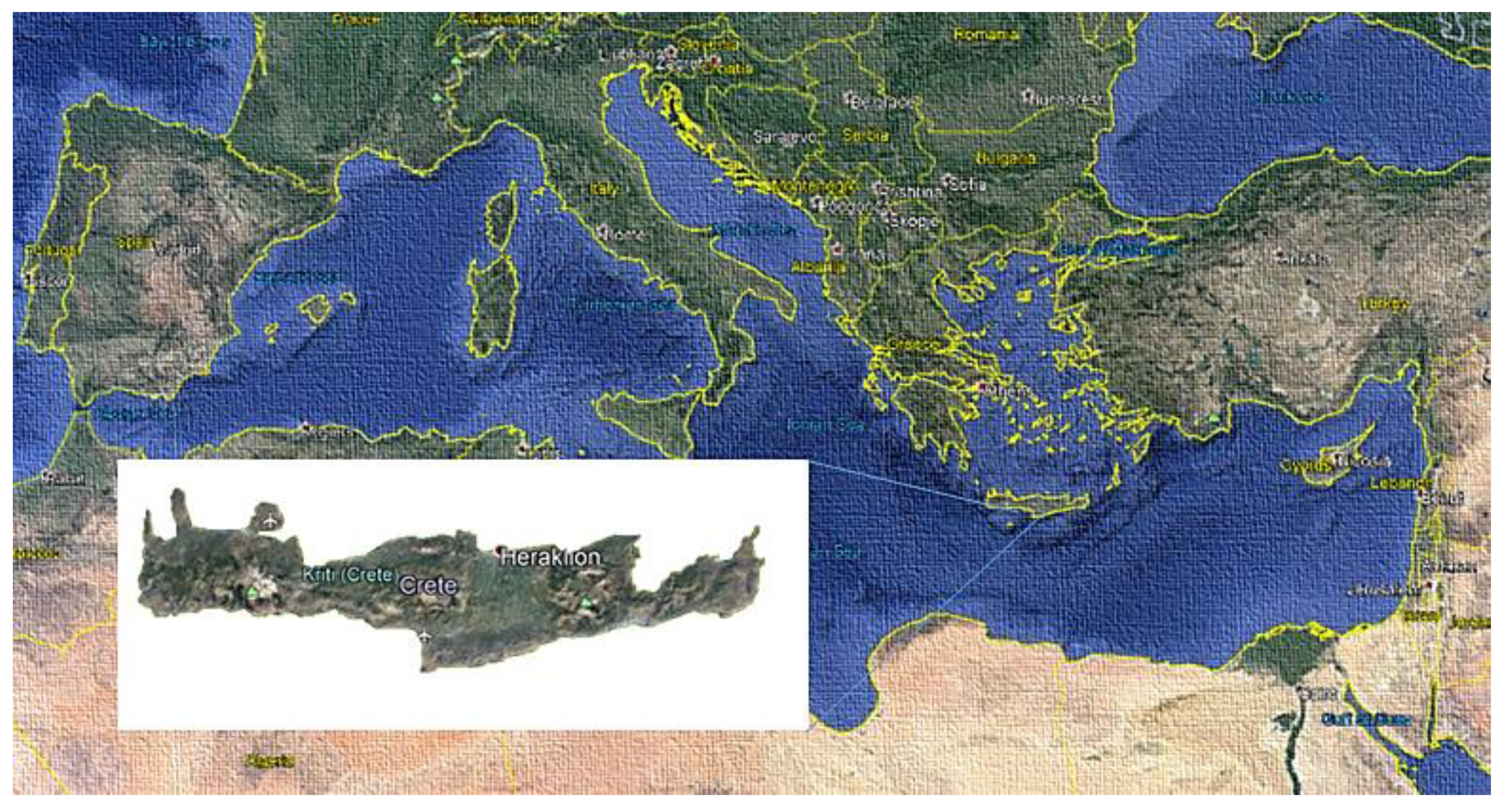
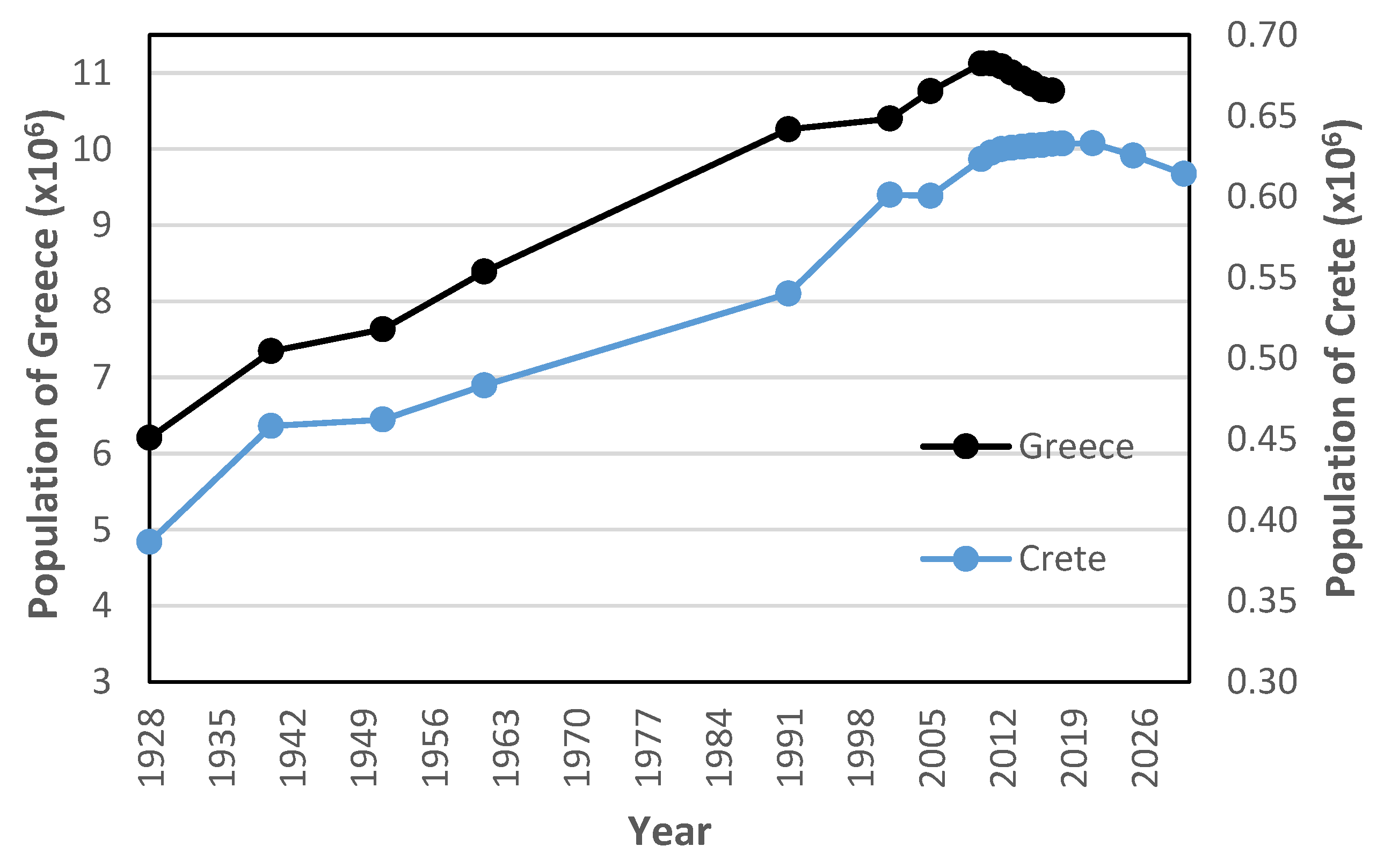

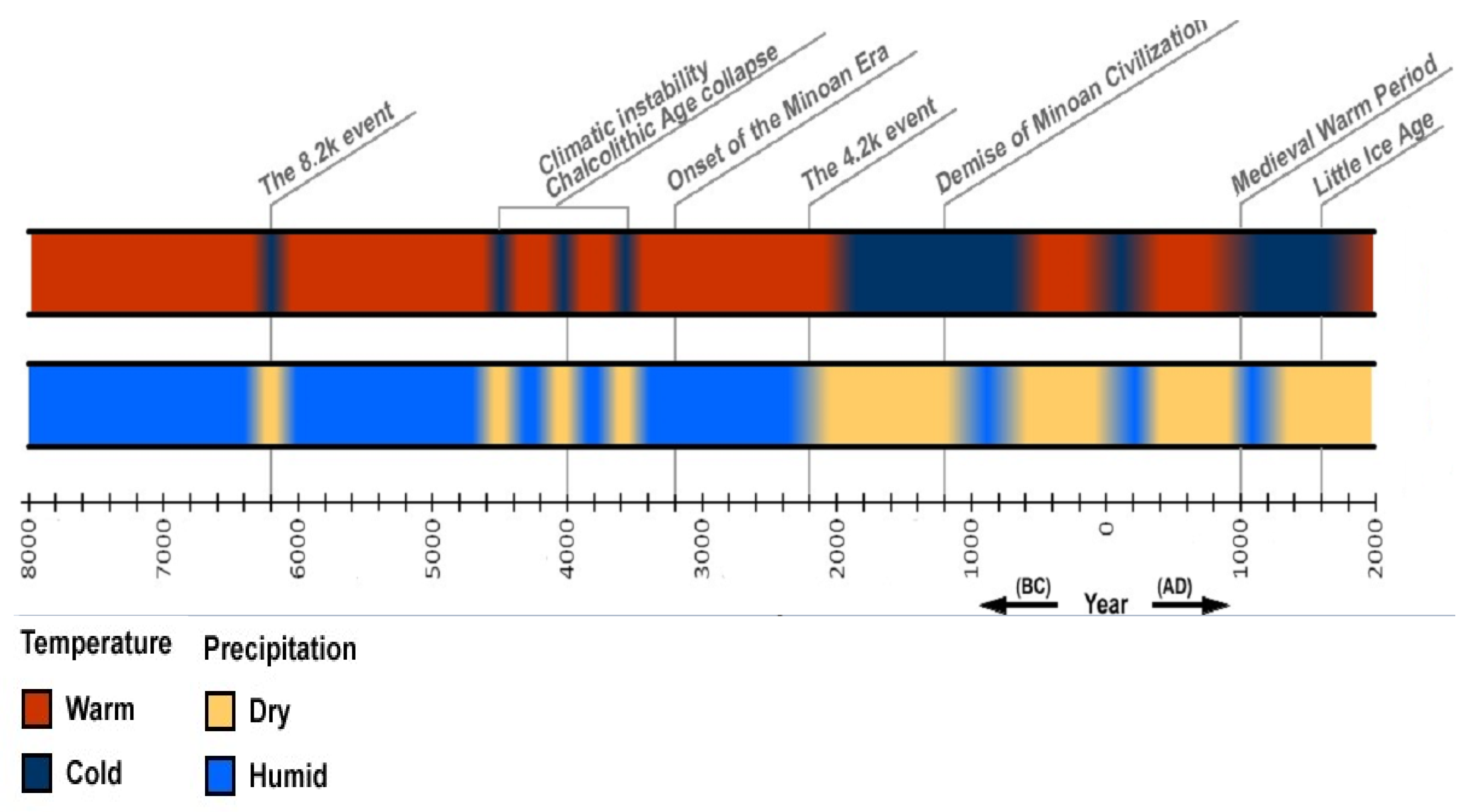
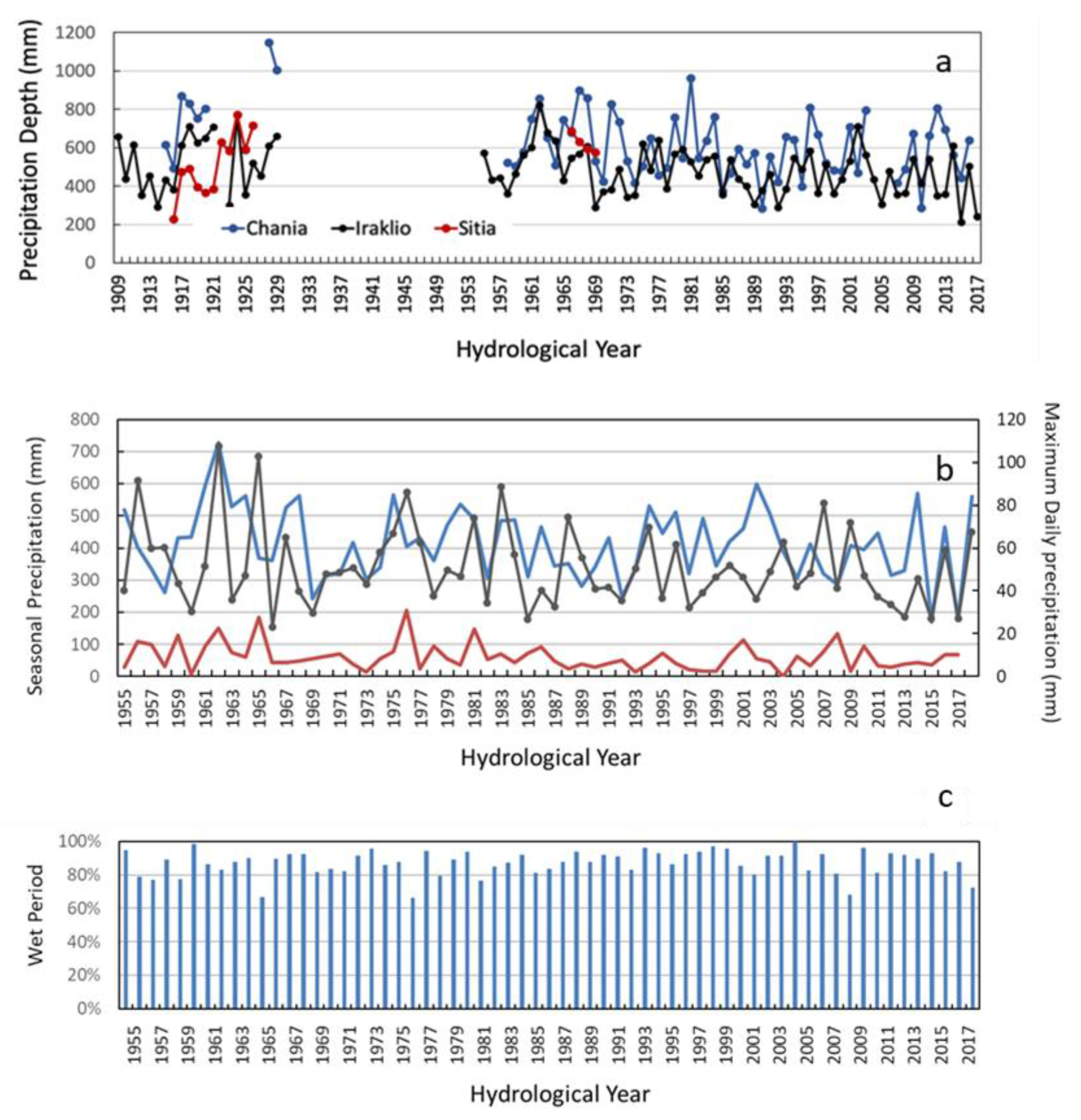
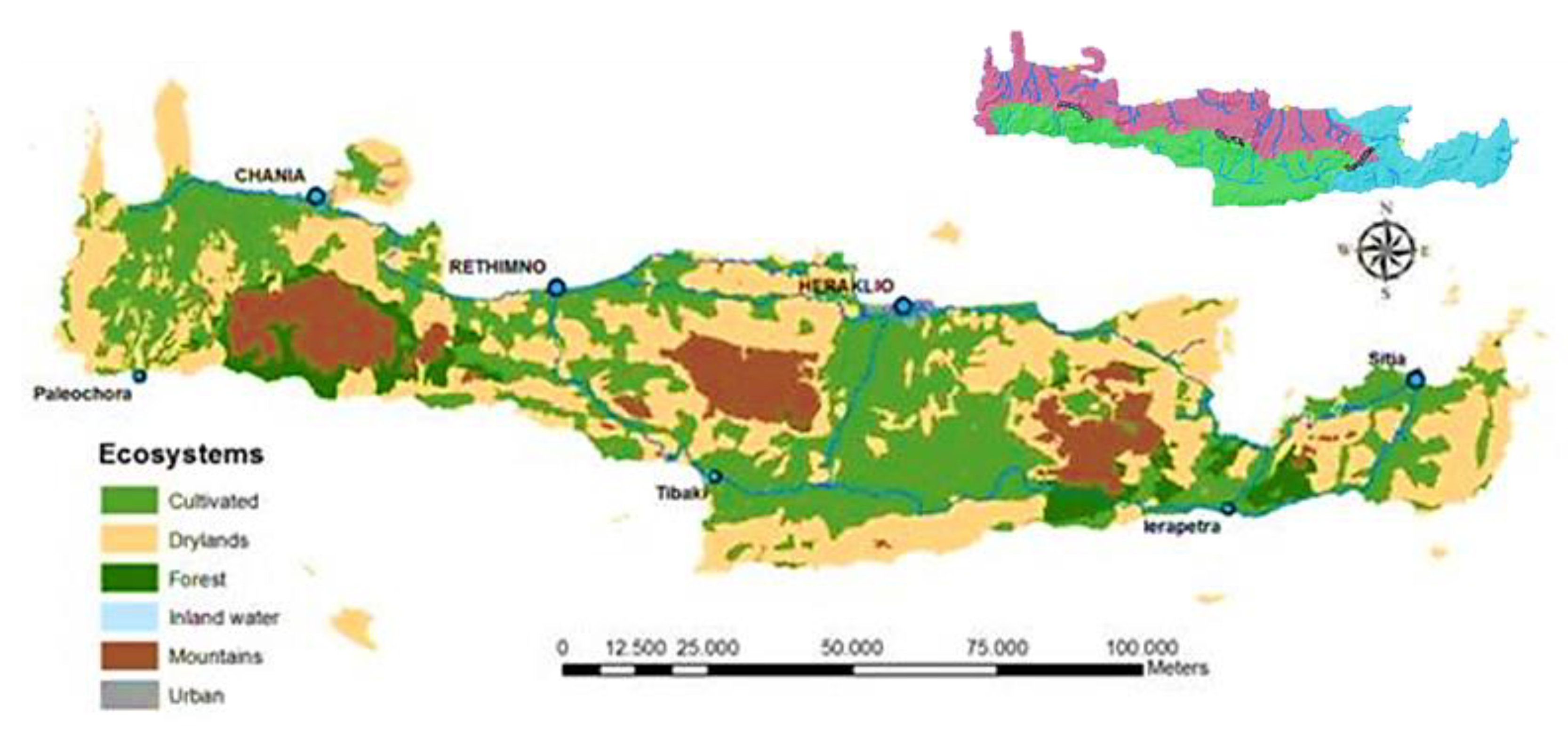
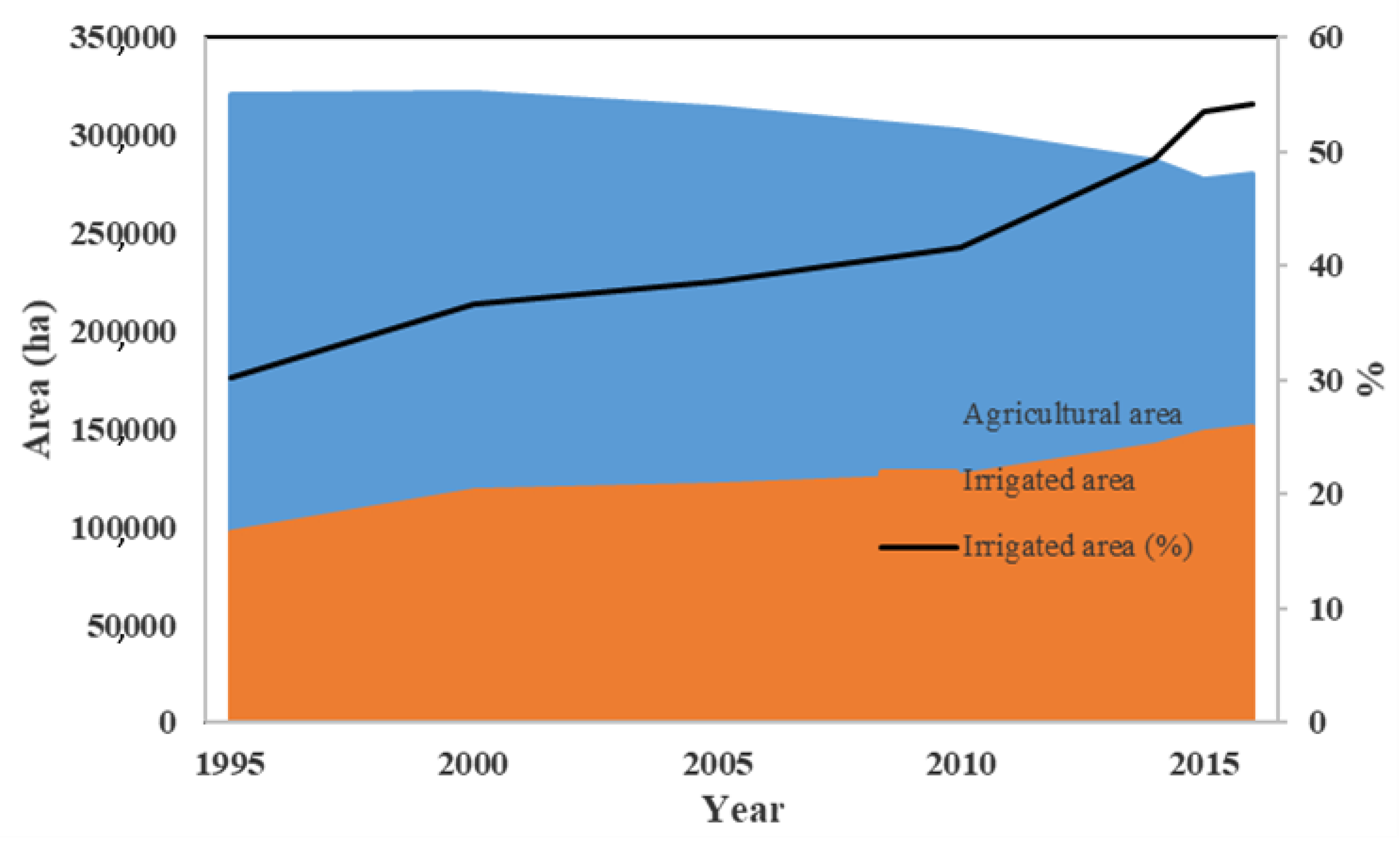
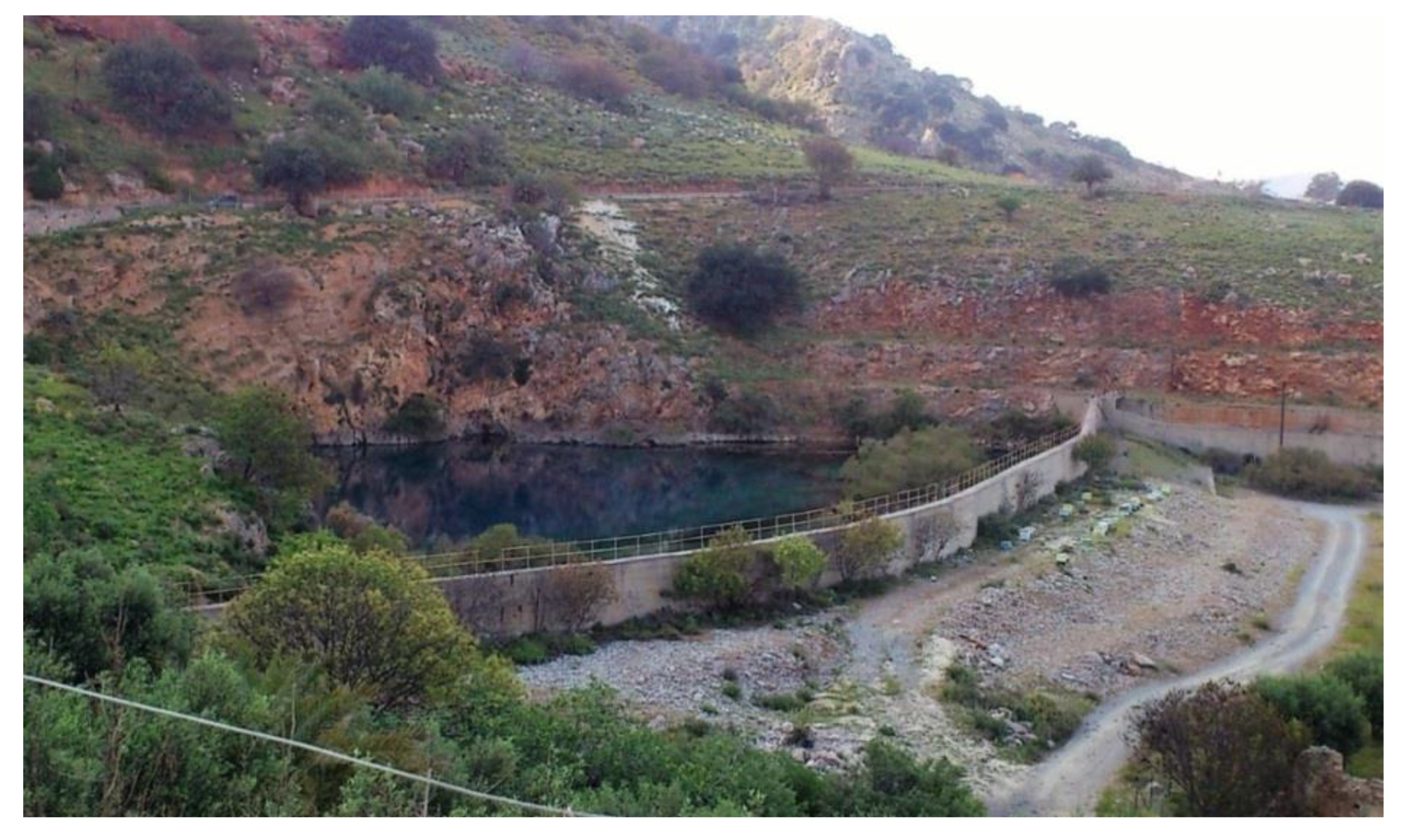
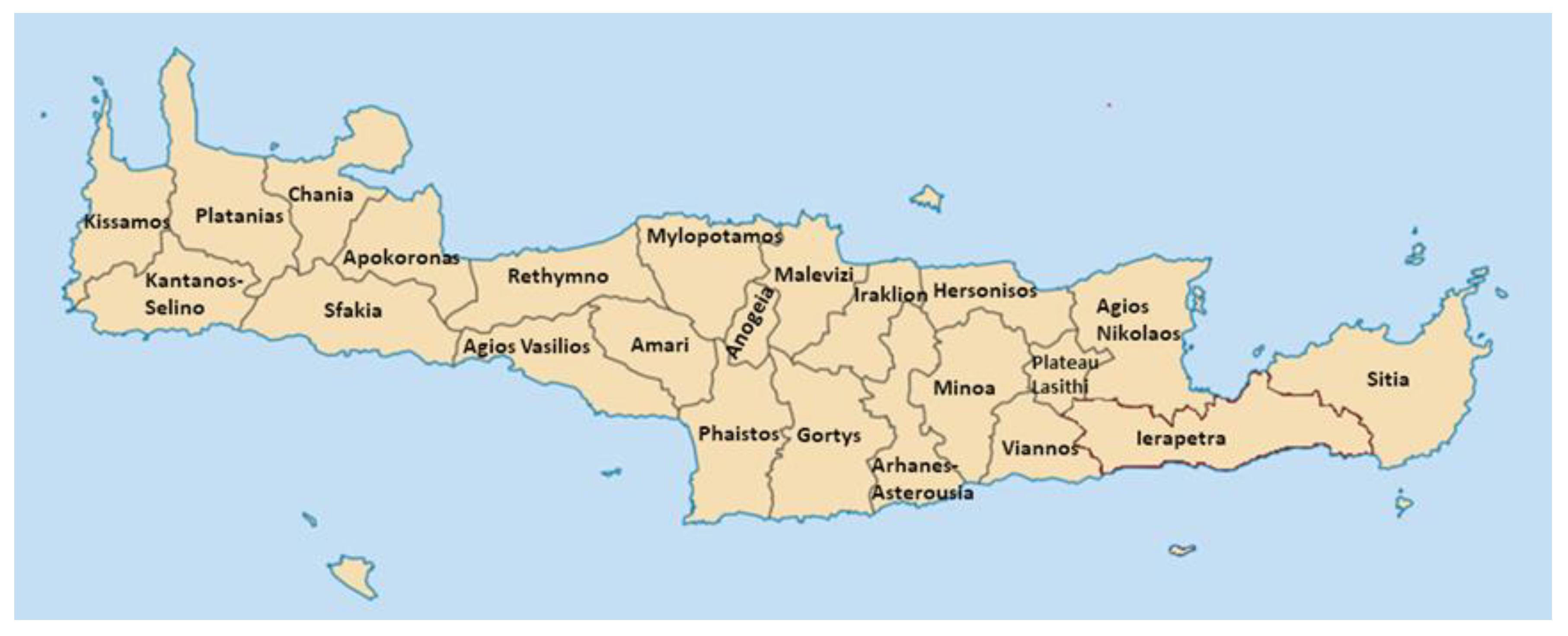
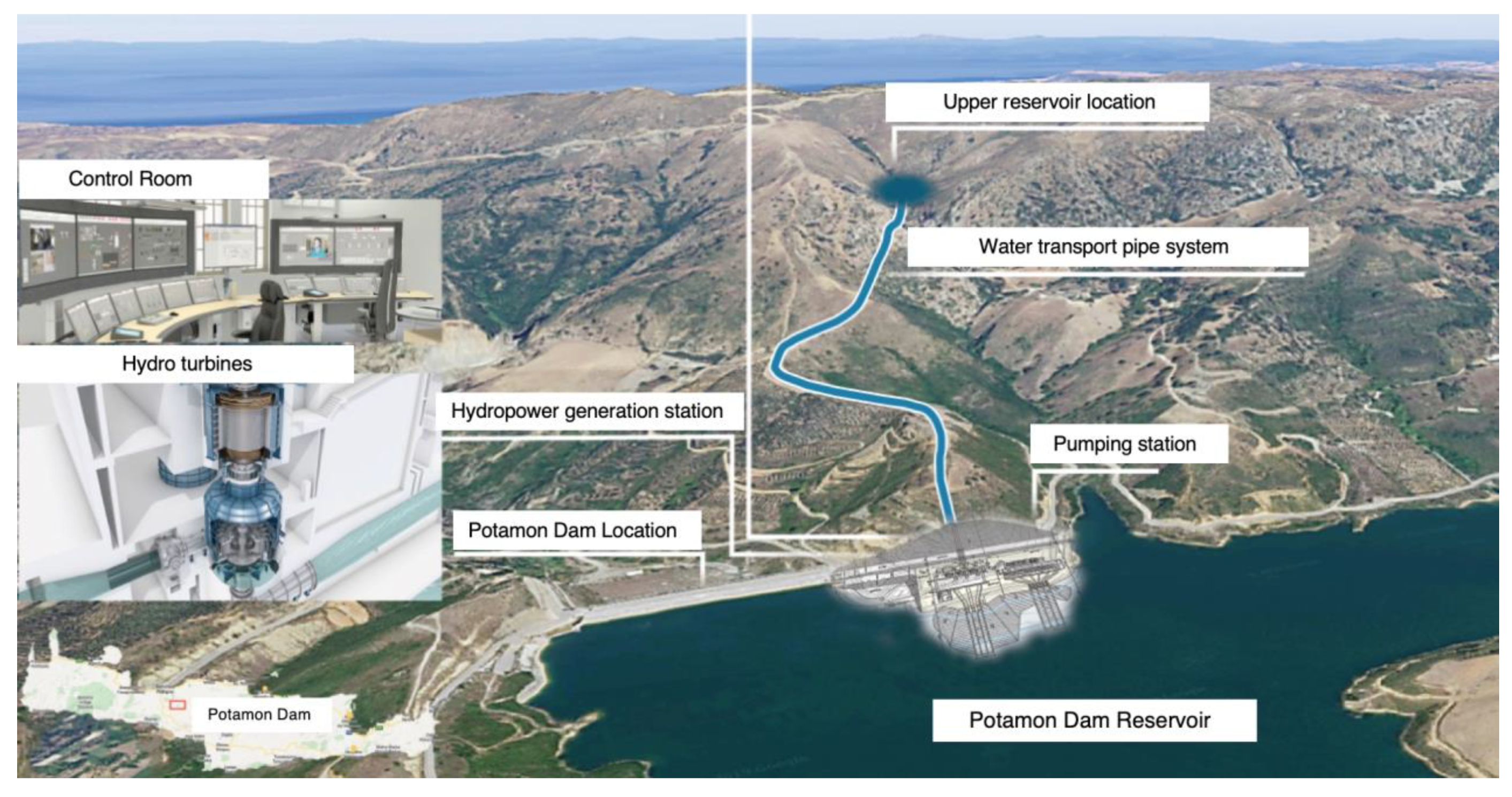
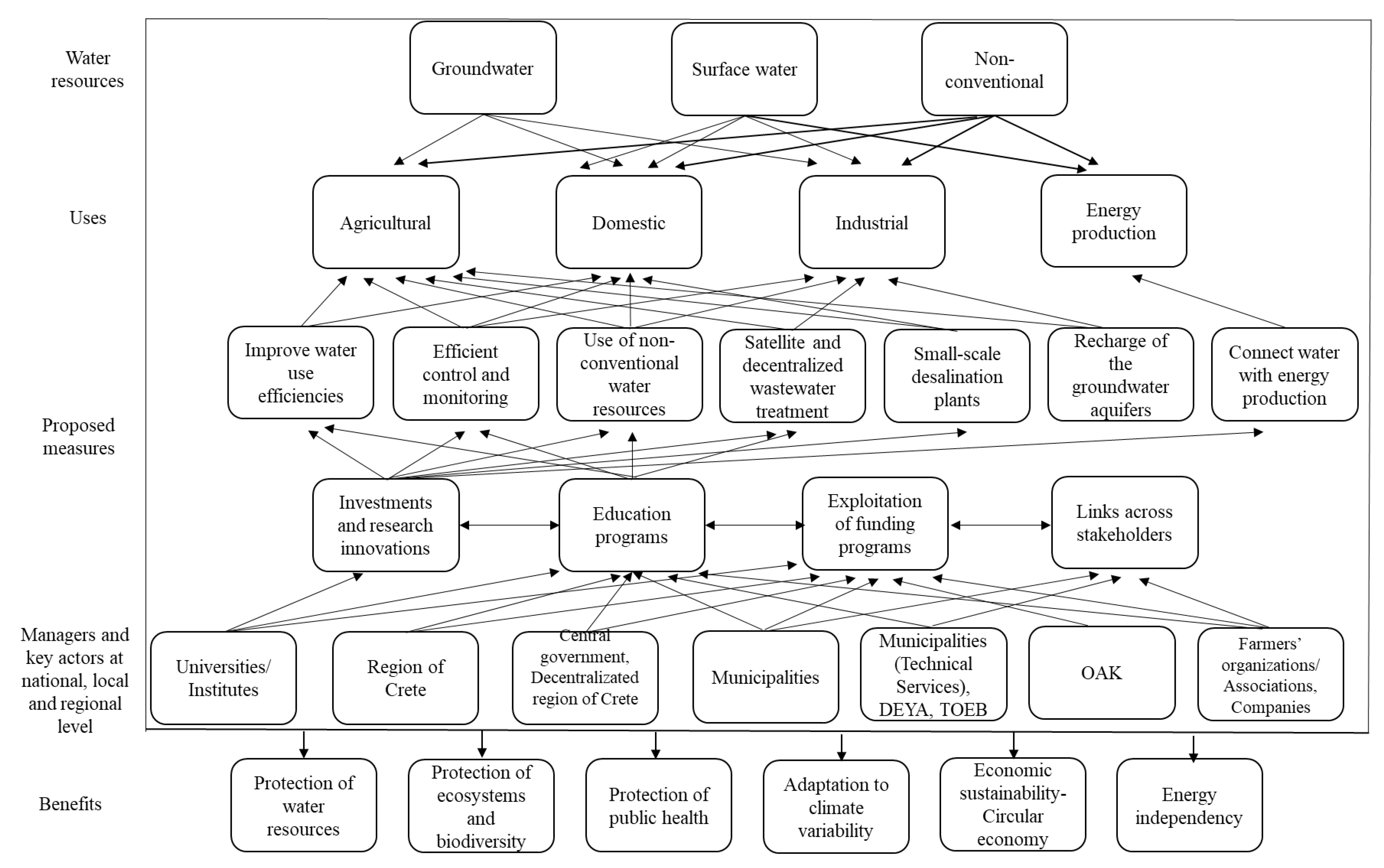
| Hydrologic Conditions | Unit | Precipitation | Actual ET (57.50%) | Run-off (15.00%) | Infiltration (27.50%) |
|---|---|---|---|---|---|
| Normal year | mm | 967 | |||
| hm3 | 8060.91 | 4635.02 | 1209.14 | 2216.75 | |
| Wet year | mm | 1244 | |||
| hm3 | 10,369.98 | 5962.74 | 1555.50 | 2851.74 | |
| Dry year | mm | 610 | |||
| hm3 | 5084.96 | 2923.85 | 762.75 | 1398.36 | |
| Year 2017–2018 | mm | 480 | |||
| hm3 | 4001.28 | 2300.74 | 600.19 | 1100.35 |
| Drainage Basin | Agriculture (%) | Forest and Semi-Natural Areas (%) | Artificial Areas (%) | Water Lands (%) |
|---|---|---|---|---|
| EL1339 | 45.65 | 51.06 | 3.22 | 0.07 |
| EL1340 | 42.54 | 56.90 | 0.50 | 0.05 |
| EL1341 | 35.68 | 62,51 | 1.76 | 0.05 |
| Average | 42.38 | 55.59 | 1.98 | 0.06 |
| Parameter | Unit | RBD of Crete |
|---|---|---|
| Area | km2 | 8336.00 |
| Precipitation | mm | 967.00 |
| Volume of precipitation | hm3 | 8060.91 |
| Evapotranspiration | hm3 | 4635.02 |
| Percolation | hm3 | 2216.75 |
| Surface runoff | hm3 | 1209.14 |
| Theoretical water potential | hm3 | 3425.89 |
| Source | Water Uses in 2016 (hm3/Year) | ||||
|---|---|---|---|---|---|
| Domestic | Agriculture | Livestock | Industry | Total | |
| Surface water | 39.40 (30.87%) | 34.60 (7.23%) | 2.10 (50.48%) | 0.27 (36.00%) | 76.37 |
| Sub-surface water | 88.21 (69.10%) | 443.81 (92.77%) | 2.08 (50.00%) | 0.48 (64.00%) | 534.58 |
| Total | 127.65 | 478.39 | 4.16 | 0.75 | 610.94 |
| Consumption index (%) | 20.89 | 78.30 | 0.68 | 0.12 | NA |
| Total | Mixed | Agricultural | Livestock | |||||
|---|---|---|---|---|---|---|---|---|
| Holdings/Areas | Hold-ings | Area (ha) | Hold-ings | Area (ha) | Hold-ings | Area (ha) | Hold-ings | Area (ha) |
| Region of Crete | 87,040 | 364,096 | 14,590 | 225,867 | 71,619 | 125,197 | 831 | 13,032 |
| Iraklion | 41,162 | 144,098 | 4787 | 70,068 | 36,184 | 70,348 | 191 | 3682 |
| Lasithi | 12,981 | 41,063 | 1168 | 19,903 | 11,729 | 19,507 | 84 | 1653 |
| Rethimnon | 13,024 | 93,703 | 4517 | 76,238 | 8131 | 14,133 | 376 | 3332 |
| Chania | 19,873 | 85,232 | 4118 | 59,658 | 15,575 | 21,209 | 180 | 4366 |
| Total (Incl. Fallow Land) | Crops on Arable Land | Garden Area | Vineyards | Tree Crops | Fallow Land | |
|---|---|---|---|---|---|---|
| Total area (ha) | ||||||
| Region of Crete | 280,075 | 20,774 | 6965 | 18,962 | 203,946 | 29,427 |
| Iraklion | 129,046 | 10,173 | 2814 | 15,012 | 90,588 | 10,459 |
| Lasithi | 52,517 | 3008 | 1953 | 1459 | 36,043 | 10,054 |
| Rethimnon | 41,956 | 4377 | 609 | 934 | 29,348 | 6688 |
| Chania | 56,556 | 3217 | 1590 | 1558 | 47,966 | 2226 |
| Irrigated area (ha) | ||||||
| Region of Crete | 151,550 | 11,550 | 7195 | 13,590 | 119,216 | |
| Iraklion | 87,643 | 6821 | 3090 | 12,519 | 65,212 | |
| Lasithi | 24,731 | 1851 | 1915 | 567 | 20,398 | |
| Rethimnon | 8761 | 374 | 594 | 85 | 7708 | |
| Chania | 30,416 | 2504 | 1596 | 419 | 25,898 | |
| Name | Location | Period of Contraction | Type | Total Volume (hm3) | Usable Volume (hm3) | Comments |
|---|---|---|---|---|---|---|
| Regular dams | ||||||
| Potamon | Amari, Rethymnon | 1995–200 2003–2008 | Earth dam | 22.50 | 17.50 | Water supply and irrigation |
| Aposelemis | Avdou, Iraklion | 2006–2012 | Earth dam | 25.27 | 24.36 | Irrigation |
| Valsamiotis | Vatolakos, Chania | 2005–2014 | RCC a (FSHD) | 6.00 | 5.90 | Irrigation |
| Faneromeni | Western Messara | 2005 | Earth dam | 19.67 | Irrigation | |
| Mpramianon | Ierapetra | 1986 | Earth dam | 16.00 | Irrigation | |
| Ini | Iraklion | 2002 | Earth dam | 1.75 | Irrigation | |
| Damanion | Iraklion | 2003 | Earth dam | 1.50 | Irrigation | |
| Amourgeles | Iraklion | 2004 | 1.56 | Irrigation | ||
| Plakiotisas | Iraklion | Earth dam | 18.60 | Irrigation/ Under construction | ||
| Chalavrianou | Iraklion | 2018 | Earth dam | 1.20 | Irrigation and Water supply | |
| Partiron | Iraklion | 2000 | Earth dam | 1.50 | Irrigation | |
| Armanogion | Iraklion | 2004 | Earth dam | 1.50 | Irrigation | |
| Agias | Chania | 1929 | Earth dam | 0.13 | Energy, Water supply and Irrigation | |
| Gerakari | Rethymnon | Earth dam | 1.75 | 1.45 | Irrigation | |
| Under planning (Major) | ||||||
| Plati Potamou | Agia Galini, Rethymnon | 51.00 | Irrigation | |||
| System of 3-dams | Chania | 45.00 | Irrigation | |||
| Dematiou | Iraklio | 30.00 | Irrigation | |||
| Agiou Ioanni | Lasiyhi | 18.50 | Irrigation | |||
| Lithinon | Lasithi | 9.00 | Irrigation | |||
| Small dams (limnodecsamenes) | ||||||
| Vizariou | Rethimnon | 1994 | 0.66 | Irrigation | ||
| Agiou Georgiou | Lasithi plateau | 2008–2012 | 2.15 | Irrigation | ||
| Chavga | Lasithi plateau | 1995 | 0.86 | Irrigation | ||
| Karavado | Iraklion | 1996 | 0.11 | Irrigation | ||
| Agion Theodoron | Chania | 1998 | 0.65 | Irrigation | ||
| Anogion | Rethymnon | 2001 | 0.75 | Irrigation and Water supply | ||
| Gergeri | Iraklion | 2001 | 0.26 | Irrigation | ||
| Chrisoskalitisa | Chania | 2005 | 0.56 | Irrigation | ||
| Arkadiou | Rethymnon | 2006 | 0.60 | Irrigation | ||
| Thrapsanou | Iraklion | 2006 | 0.21 | Irrigation | ||
| Kountouras | Chania | 2008 | 0.65 | Irrigation | ||
| Skinia | Iraklion | 1997 | 0.38 | Irrigation | ||
| Elous | Chania | 0.35 | Irrigation/ Under construction | |||
| Omalou | Chania | 0.50 | Irrigation/ Under construction | |||
| Zou | Lasithi | 0.30 | Irrigation/ Under construction | |||
| Hydrogeological Formations | Area (km2) | Average Annual Precipitation (mm) | Volume of Precipitation (hm3/Year) | Average Percolation (%) | Volume of Percolated Water (hm3/Year) |
|---|---|---|---|---|---|
| Karstic | 3333.07 | 1300 | 4332.99 | 34.85 | 1510.24 |
| Neogenic | 2950.92 | 693 | 2044.99 | 23.75 | 485.66 |
| Others | 2052.01 | 780 | 1600.57 | 11.02 | 176.41 |
| Total/Average | 8336.00 | 967 | 8060.91 | 27.50 | 2216.75 |
| Population Served | WWTPs (no) | Capacity (hm3/Year) | Reused (hm3/Year) | Reuse Opportunities | Comments |
|---|---|---|---|---|---|
| <2000 | 67 | 3.90 | 0.75 | Agricultural irrigation. | Numerous additional small projects (more than 650a) serving less than 2000 persons are in various stages of planning and development. When completed, these treatment plants will serve 15%-20% of the total population of Crete. |
| 2000–5000 | 15 | 4.65 | 0.90 | Agricultural irrigation and landscape irrigation. | Two more plants are under implementation and three are under construction. |
| 5000–15,000 | 10 | 8.90 | 2.25 | Agricultural irrigation, landscape irrigation, and groundwater recharge. | One more plant remains under implementations and another one is under construction. When those treatment plants (including the above) are completed, the total population served will rise above 80%. |
| 15,000–100,000 | 5 | 12.00 | 0.55 | Agricultural irrigation, landscape irrigation, groundwater recharge, and indirect and direct potable reuse. | |
| 100,000–150,000 | 1 | 10.20 | Agricultural irrigation and landscape irrigation. | ||
| >150,000 | 1 | 14.50 | 1.00 | Agricultural irrigation, landscape irrigation, groundwater recharge, and indirect and direct potable reuse. | |
| Total | 99 | 54.15b | 5.45c |
| Municipalities | Existing | Proposed |
|---|---|---|
| Chania | DEYA Chania | DEYA Chania |
| Platanias | DEYA North Axis | DEYA North Axis |
| Kantanos-Selino | DEYA Kantanos-Selino | DDEYA Kissamos-Kantanos- Selino |
| Kissamos | ||
| Apokoronas | DDEYA Apokoronas- Sfakia | |
| Sfakia | ||
| Gavdos | DEYA Gavdos | |
| Rethymno | DEYA Rethymnon | DEYA Rethymnon |
| Mylopotamos | DEYA Mylopotamos | DDEYA Mylopotamos- Anogeia |
| Anogeia | ||
| Amari | DDEYA Amari- AgiosVasilios | |
| AgiosVasilios | ||
| Iraklion | DEYA Iraklion | DEYA Irakliou |
| Malevizi | DEYA Malevizi | DEYA Malevizi |
| Hersonisos | DEYA Hersonisos | DEYA Hersonisos |
| Phaistos | DEYA Phaistos | DDEYA Phaistos- Gortys |
| Gortys | ||
| Arhanes-Asterousia | DDEYA Minoa- Arhanes-Asterousia-Viannos | |
| Minoa | DEYA Minoa | |
| Viannos | ||
| Agios Nikolaos | DEYA Agios Nikolaos | DDEYA Agios Nikolaos- Plateau Lasithi |
| Plateau Lasithi | ||
| Ierapetra | DEYA Ierapetras | |
| Sitia | DEYA Sitias | DEYA Sitias |
© 2020 by the authors. Licensee MDPI, Basel, Switzerland. This article is an open access article distributed under the terms and conditions of the Creative Commons Attribution (CC BY) license (http://creativecommons.org/licenses/by/4.0/).
Share and Cite
Tzanakakis, V.A.; Angelakis, A.N.; Paranychianakis, N.V.; Dialynas, Y.G.; Tchobanoglous, G. Challenges and Opportunities for Sustainable Management of Water Resources in the Island of Crete, Greece. Water 2020, 12, 1538. https://doi.org/10.3390/w12061538
Tzanakakis VA, Angelakis AN, Paranychianakis NV, Dialynas YG, Tchobanoglous G. Challenges and Opportunities for Sustainable Management of Water Resources in the Island of Crete, Greece. Water. 2020; 12(6):1538. https://doi.org/10.3390/w12061538
Chicago/Turabian StyleTzanakakis, V. A., A. N. Angelakis, N. V. Paranychianakis, Y. G. Dialynas, and G. Tchobanoglous. 2020. "Challenges and Opportunities for Sustainable Management of Water Resources in the Island of Crete, Greece" Water 12, no. 6: 1538. https://doi.org/10.3390/w12061538
APA StyleTzanakakis, V. A., Angelakis, A. N., Paranychianakis, N. V., Dialynas, Y. G., & Tchobanoglous, G. (2020). Challenges and Opportunities for Sustainable Management of Water Resources in the Island of Crete, Greece. Water, 12(6), 1538. https://doi.org/10.3390/w12061538








